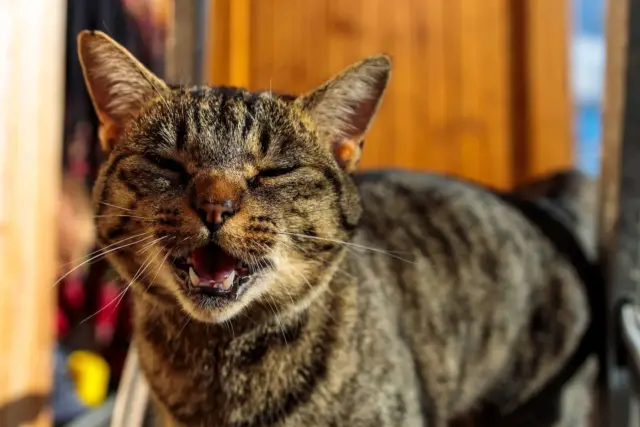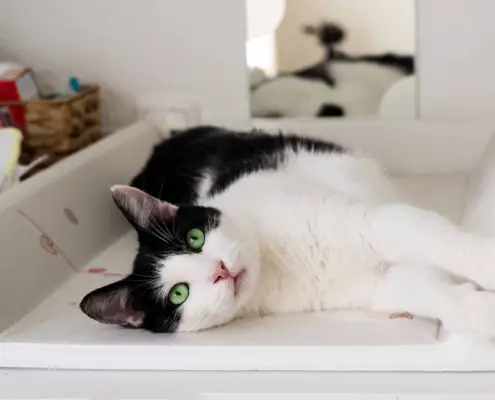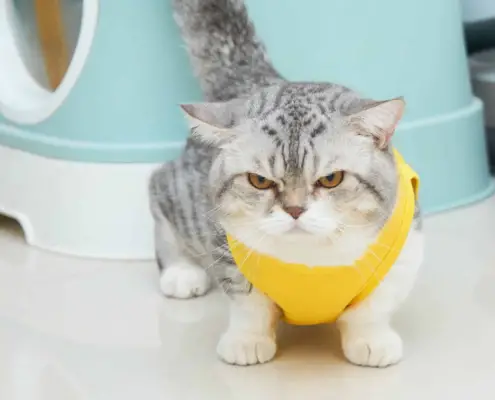Cats have long been known for their mysterious and independent nature. However, many cat owners have experienced moments of connection and understanding with their feline companions that seem to go beyond mere instinct. This has led to the intriguing question: do cats have a unique vocabulary with their owners? In order to delve into this topic, it is important to first understand the various ways in which cats communicate.

Understanding Cats’ Body Language and Vocalizations
Cats are highly expressive creatures and use a combination of body language and vocalizations to communicate their needs and emotions. By observing their posture, facial expressions, and tail movements, owners can gain valuable insights into their cat’s mood. For example, a relaxed and content cat will often have a slightly curved tail and half-closed eyes, while an agitated or fearful cat may flatten its ears and puff up its fur.
In addition to body language, cats also use vocalizations to convey their messages. From the familiar purring to the less understood meows and chirps, each sound carries its own meaning. For instance, a short and high-pitched meow is often a greeting, while a long and low-pitched meow may indicate hunger or a desire for attention. By paying close attention to these vocal cues, owners can better understand their cats’ unique language.
How Cats Communicate Through Scent
While body language and vocalizations play a significant role in cats’ communication, scent is another important avenue through which they convey messages. Cats possess scent glands in various parts of their bodies, including their cheeks, paws, and tails. By rubbing against objects or people, cats leave behind their unique scent, marking their territory and signaling familiarity.
Furthermore, cats have an incredible sense of smell that allows them to detect even the subtlest of scents. This is why they often engage in a behavior known as “scent exchange,” where they sniff each other’s faces and bodies to gather information about other cats. By understanding the importance of scent in their communication, owners can create an environment that is both familiar and comforting for their feline companions.
The Importance of Bonding in Cats’ Communication
Building a strong bond with your cat is essential for effective communication. Cats are known to be selective in their relationships, often forming strong attachments to one or a few individuals. By spending quality time with your cat, engaging in interactive play, and providing them with a safe and nurturing environment, you can establish a foundation of trust and understanding.
It is important to note that cats communicate differently with each individual, tailoring their gestures and vocalizations to the specific person. This further highlights the unique vocabulary that cats seem to develop with their owners. Through consistent interaction and positive reinforcement, owners can strengthen this bond and enhance their ability to comprehend their cat’s needs and desires.
Tips for Building a Strong Bond and Understanding with Your Cat
- Spend dedicated one-on-one time with your cat each day, engaging in activities they enjoy, such as interactive play or gentle grooming sessions.
- Respect your cat’s boundaries and provide them with a safe and quiet space where they can retreat when needed.
- Use positive reinforcement techniques, such as treats and praise, to reward desired behaviors and encourage open communication.
- Learn to interpret your cat’s body language and vocalizations by observing their behaviors in various situations.
- Be patient and understanding, as building a strong bond takes time and effort.
By following these tips, you can foster a deep connection with your cat and unlock the intricacies of their unique vocabulary.
Common Words and Phrases Cats May Understand
While cats may not comprehend human language in the same way we do, they are capable of associating certain words and phrases with specific actions or events. For example, consistently using the word “treat” when offering a reward can help cats understand the association between the word and the desired behavior.
Additionally, cats are highly attuned to the tone of voice used by their owners. They can pick up on the emotions conveyed through intonation and adjust their response accordingly. By using a warm and soothing tone, owners can create a positive and inviting environment for their cats to engage in communication.
Recognizing and Responding to Your Cat’s Unique Vocalizations
Cats have a wide range of vocalizations, each with its own distinct meaning. By listening closely to the sounds your cat makes and observing their accompanying body language, you can begin to decipher their unique vocabulary. For instance, a series of short, rapid meows may indicate excitement or anticipation, while a long and drawn-out yowl could signify distress or discomfort.
When your cat vocalizes, it is important to respond appropriately to their needs. This could involve providing food or water, offering comfort, or engaging in play. By acknowledging and responding to their vocalizations, you strengthen the bond and deepen the understanding between you and your cat.
The Role of Context in Cats’ Communication with Their Owners
Context plays a crucial role in cats’ communication with their owners. Cats are highly perceptive creatures and are sensitive to their environment. They rely on familiar routines, cues, and patterns to navigate their surroundings and interact with their owners.
For example, a cat may exhibit specific behaviors, such as rubbing against a person’s leg or vocalizing, to signal their desire for attention or affection. By paying attention to these contextual cues, owners can better understand and respond to their cats’ needs.
Celebrating the Unique Language of Cats and Their Owners
In conclusion, cats have a unique vocabulary with their owners that encompasses body language, vocalizations, and scent. By understanding and interpreting these communication methods, cat owners can develop a deeper bond with their feline companions. Through patience, observation, and a willingness to learn, we can celebrate the intricate language of cats and create a harmonious and fulfilling relationship with these enigmatic creatures.
If you enjoyed my article, I would appreciate you sharing it with your network.

Sima Ndlebe
Sima writes for CatBuzz. He is interested in Cats, Health and Fitness, and Entrepreneurship.
Published: 17 January 2024



